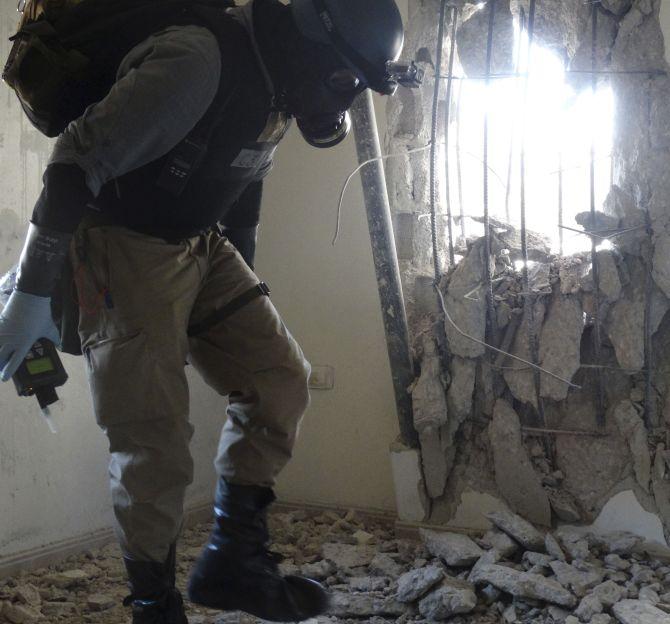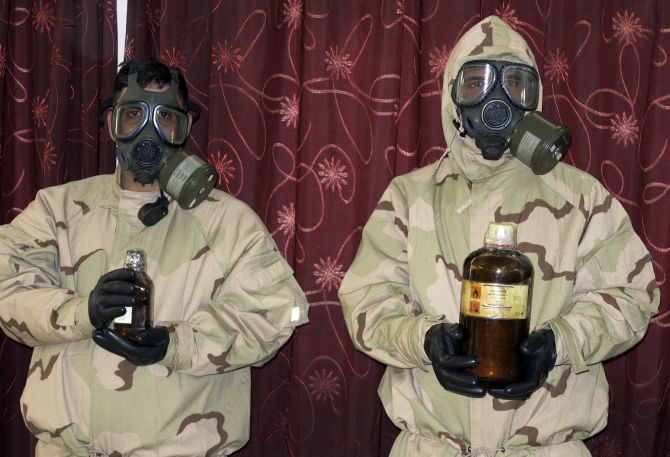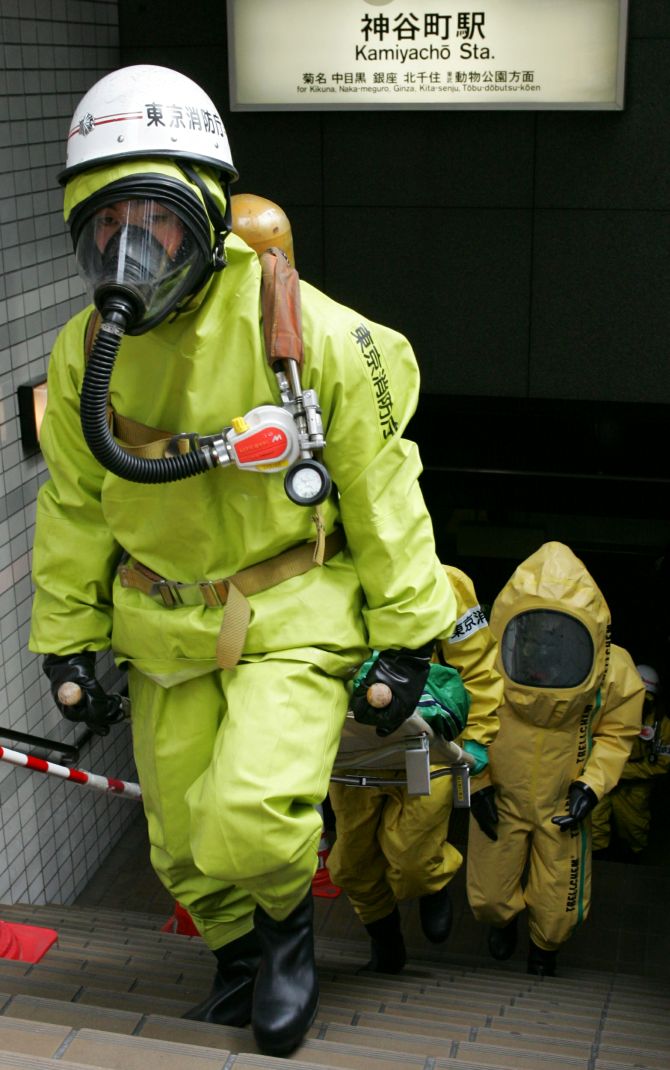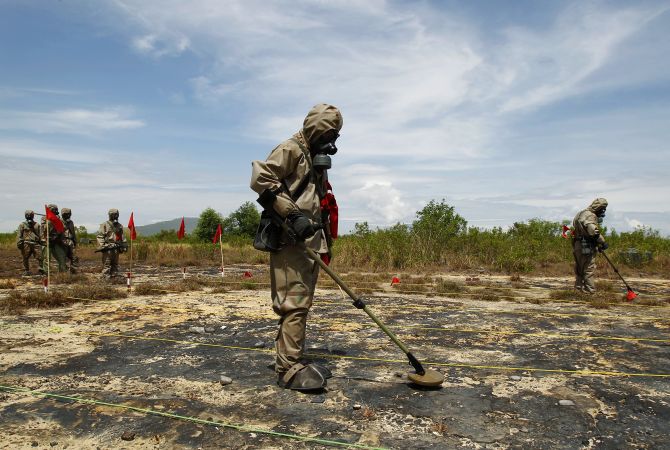Photographs: Mohammad Abdullah/Reuters
The alleged use of chemical weapons in Syria by President al-Assad's forces in a Damascus suburb last week has been strongly condemned by the international community.
The August 21 attacks, which left at least 355 people dead, were launched on opposition-controlled areas. The Syrian government and the Syrian rebels have blamed each other for the attack.
The United States and the United Kingdom appeared to have backed down from an immediate punitive military strike against Syria before hearing the results of a UN probe into the alleged poisonous gas attacks in the war-torn country.
The alleged chemical attacks is said have occurred around 3 am on 21 August in the Ghouta agricultural area near Damascus. Activists say that hundreds of people died of gas inhalation and exposure to a nerve gas.
On 24 August, three days after the incident, the United Nations formally requested that its weapons inspectors be permitted to examine the sites of the alleged chemical weapons attacks. The Syrian government agreed.
Statements made by witnesses to various media organisations reported of symptoms like headaches, nausea suffocation redness and itching of the eyes, muscle spasms and frothing at the mouth.
Meanwhile, President Assad continues to remain defiant. He has vehemently denied the use of chemical weapons in an attack on the eastern suburbs of Damascus,
But this is not the first time chemical weapons have been used in conflict. Rediff.com takes a look at previous times these deadly weapons were used.
…
Iran-Iraq war
Image: Soldiers wearing gas masks hold bottles containing chemical materials during a news conference at the Defence Ministry in BaghdadPhotographs: Reuters
When Iran and Iraq were at war between 1980 and 1988, Iraqi leader Saddam Hussein used mustard gas and sarin -- a colorless, odorless liquid, used as a chemical weapon owing to its extreme potency as a nerve agent -- against Iran.
Foreign Policy has published a report showing the extent of the US government’s complicity in Saddam Hussein’s use of chemical weapons during the war.
The chemical weapons attacks worked for the Iraqi’s and Iran was forced into negotiations. Thousands of Iranian soldiers were killed in the deadly strike.
Halabja poison gas attack, March 1988
Iraqi forces used chemical weapons in the Kurdish town of Halabja in Southern Kurdistan on March 16, 1988.
The attack is said to have killed between 3,200 and 5,000 people, while around 7,000 to 10,000 people were injured in the attack. It was an act of act of genocide against the Kurdish people in Iraq.
Iraqi aircrafts dropped chemical bombs on Halabja's residential areas in a five-hour attack.
Saddam's cousin Ali Hassan al-Majid, who ordered the attack, came to be known as Chemical Ali.
...
Tokyo Subway Attack, March 1995
Image: Special incident unit members from the Tokyo Fire Department and Tokyo Metropolitan Police Department conduct nuclear, biological and chemical disaster drills at Tokyo's Kamiyacho subway stationPhotographs: Reuters
The Subway Sarin Incident consisted of five coordinated attacks where the attackers released sarin -- a highly toxic chemical nerve agent -- on several lines of the Tokyo subway.
Thirteen people were killed and thousands others were injured in the attack. Ten men were responsible for carrying out the attacks: five released the sarin, while the other five served as get-away drivers.
17 years after the attack, a member of the Japanese religious cult -- Aum Shinrikyo doomsday -- responsible for releasing the nerve agent, was arrested.
Nearly 200 members of the cult were convicted in the attack.
...
World War I
Image: Participants dressed in 1916 Romanian troops uniforms stand behind their banner before the re-enactment of a battle in World War One at a Military History festival organised in Fundata village near BucharestPhotographs: Radu Sigheti/Reuters
World War I saw the introduction of chemical weapons. Weapons employed included tear gas, mustard gas, and lethal agents like phosgene and chlorine. However, the killing capacity of gas was limited, with only four percent of combat deaths caused by gas.
On April 22, 1915 German soldiers used around 6,000 gas cylinders facing the French lines near Ypres in Belgium. Many chocked on the greenish-yellow gas and died where they stood. Many others rendered blind retreated in panic. Aroud 2,000 French Colonial troops were captured by the Germans, who hardly fired a shot.
The French army was the first to use gas to attack the enemy but chemicals were used more as irritants rather than fatal poisons. In August 1914, the French army used grenades with tear gas in their attacks.
An estimated 1,00,000 casualties from gas attacks in World War I prompted the League of Nations to draft a document prohibiting chemical and biological warfare. More than 30 nations signed the Geneva Protocol in 1925.
…
Vietnam War
Image: Soldiers detect Unexploded Ordnance (UXO) and defoliant Agent Orange during the launch of the "environmental remediation of dioxin contamination" project, in Vietnam's central Da Nang CityPhotographs: Kham/Reuters
Operation Ranch Hand, the US military’s chemical weapons programme during the Vietnam War from 1961 to 1971, saw the use of Agent Orange.
The United States military sprayed nearly 20,000,000 US gallons of material containing chemical herbicides and defoliants mixed with jet fuel in Vietnam to defoliate forested and rural land.
The Vietnam Red Cross reported that as many as 3 million Vietnamese people have been affected by Agent Orange. At least 1,50,000 children were born with birth defects
According to Vietnam an estimated 4,00,000 people were killed or maimed.
Napalm was another substance that became infamous during the Vietnam War. A sticky, gasoline-like substance that could melt skin was developed in a secret laboratory at Harvard University in Massachusetts.
It was employed for its tactical as well as psychological effects. Reportedly, about 388,000 tons of napalm bombs were dropped in Vietnam between 1963 and 1973.






article